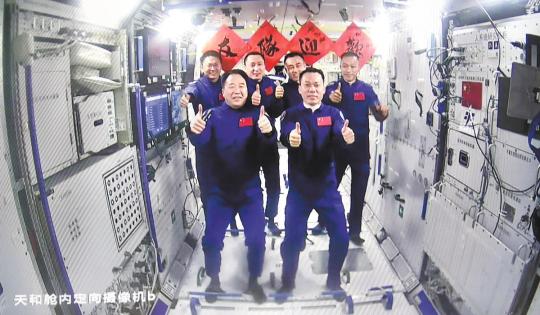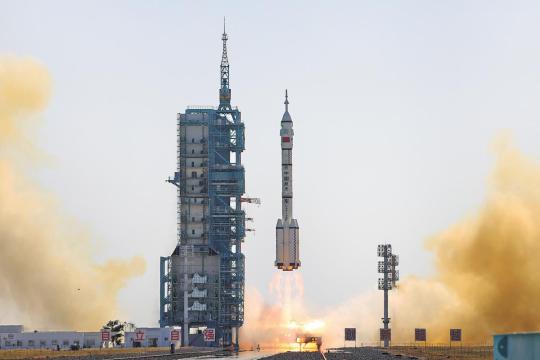
Crew members of the Shenzhou XVI and Shenzhou XVII space missions pose for a group photo in the orbiting Tiangong space station on Thursday after the Shenzhou XVII spacecraft docked with the front port of the Tianhe core module, the main body of Tiangong. (Photo by XU BU/For China Daily)
Crew members of Shenzhou XVII — China's 12th manned spaceflight — arrived at the Tiangong space station on Thursday evening, joining their peers from the Shen-zhou XVI mission who have been in orbit for five months.
A Long March 2F rocket, carrying the spaceship with mission commander Senior Colonel Tang Hongbo, Lieutenant Colonel Tang Shengjie and Lieutenant Colonel Jiang Xinlin on board, lifted off at 11:14 am from the Jiuquan Satellite Launch Center in northwestern China's Gobi Desert.
After a six-and-a-half-hour flight, the Shenzhou XVII spaceship docked with the front port of the Tianhe core module, the main body of Tiangong.
The Shenzhou XVII crew members hail from the People's Liberation Army Astronaut Division. The mission is the first spaceflight of Tang Shengjie and Jiang, who are from China's third generation of astronauts.
The mission has also made Tang Hongbo, who belongs to the nation's second generation of astronauts, the first person to return to Tiangong. His first space journey was on board the three-month-long Shenzhou XII mission, the first manned flight to Tiangong, which concluded two years and one month ago.
Following the docking process, the Shenzhou XVII crew spent nearly two hours on preparatory work to enter the space station, which included changing into intravehicular work suits from their pressure suits.
Meanwhile, the Shenzhou XVI crew — mission commander Major General Jing Haipeng, Colonel Zhu Yangzhu and Professor Gui Haichao — waited inside the connection cabin. After all preparations were done, Jing's team opened a hatch in the connection cabin at 7:34 pm to welcome the new team of astronauts.
The first to step out of the Shen-zhou XVII spaceship was Tang Hongbo, followed by Tang Shengjie and Jiang, who were all greeted with hugs by Jing, Zhu and Gui. The astronauts then exchanged thoughts inside the Tianhe module.
Jing said he and his team were very happy and excited to see their "brothers from Shenzhou XVII". He pointed to a banner his team had placed inside the Tianhe module that read, "Welcome, our teammates".
"We have been in space for nearly five months and we missed you so much," Jing said. "We know that you trained very hard and made all-out efforts to prepare for your mission. … Now, you have realized your dream of being in this space station and we want to extend our heartiest congratulations."
The meeting of the two teams is very meaningful because it marks the first space-based gathering of crew members from China's first, second and third generations of astronauts, said Jing, who is from China's first generation of astronauts. With the arrival of the Shen-zhou XVII crew, 20 Chinese astronauts have made it to the Earth's orbit, he added.

The Shenzhou XVII spaceship lifts off on Thursday from the Jiuquan Satellite Launch Center in northwestern China. Perched atop a Long March 2F carrier rocket, the spaceship, with three Chinese astronauts on board, blasted off at 11:14 am. (Photo by ZHU XINGXIN/China Daily)
Tang Hongbo thanked Jing and his team for the warm welcome, and said that returning to Tiangong "makes me feel I am at my space home again".
"Your outstanding performance during the past five months has set a very good example for us. We closely followed your work and learned a lot from you when we trained on the ground," said the Shenzhou XVII mission commander.
Jiang echoed Tang Hongbo and said they will continue to learn from the Shenzhou XVI astronauts during the space station handover process.
After their talks, the six astronauts took a group selfie amid cheers from ground controllers. The event was broadcast by China Central Television.
The handover process will take place over the next four days, and the Shenzhou XVI crew will return to Earth on Tuesday. The Shenzhou XVII crew will man the space station for about six months and return in April.
In addition to their routine tasks, the Shenzhou XVII crew members will perform experimental repair operations during spacewalks, according to the China Manned Space Agency.
Pang Zhihao, an expert on space exploration technology and a renowned spaceflight writer, said that repair capabilities and skills are crucial to any long-working spacecraft.
"Tiangong is set to operate in orbit for more than 10 years. It is understandable that any spacecraft designed to have such a long life span runs the risk of external impacts, particularly from space debris," Pang said.
"Our space station is in good condition so far, but we need to be well prepared for every possible scenario. It is very important for our astronauts to be able to fix broken parts or replace them with new ones," he added.

Popular Videos
Hot comments
- China Life: Chinese women shine with She Power
- First apes at U.S. zoo receive COVID-19 vaccine made for animals, zoo official says
- 86-year-old grandma in Hebei spends most her life on traditional cheongsam
- Homemade curling videos trending in China
- China-ASEAN Expo witnesses changes in tech, life over 18 years
- Asia is young!
- 16-year-old Chinese girl reaches summit of Mt. Qomolangma
- Xi says China ready to promote win-win cooperation with U.S.
- Lantern Festival: A romantic celebration in China
- 'Escape from the British Museum' series gains online attention
Top Reviews
- Collaborative efforts needed for better China-U.S. relations
- Li Keqiang passes away
- China-U.S. financial working group holds first meeting
- Shenzhou XVII astronauts join peers in Tiangong
- Archaeologists uncover rare sheep-drawn carriage in Xi'an
- China makes breakthrough in obtaining kilogram-level molybdenum isotope
- Xizang undergoes rapid development over past decade: cultural industry insider
- Overseas graduates eligible for civil posts
- Patriotic education law to be promoted in Hong Kong, Macao
- Nandan's Mangchang becomes nationally strong agri town







